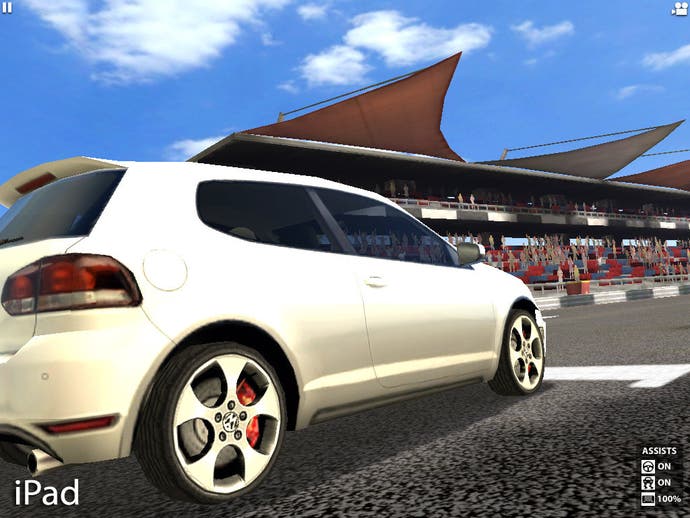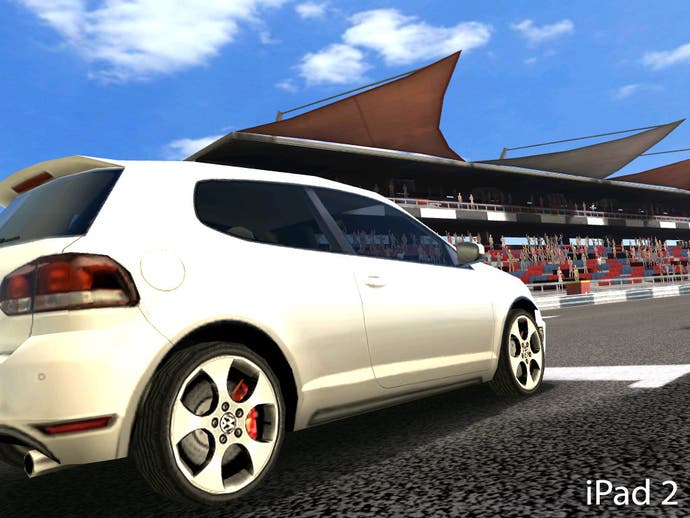Digital Foundry vs. iPad 2
Why you should upgrade and how the A5 tech could power a new home console.
The signs are there if you look for them. Apple recently appointed key games industry personnel to its UK operation in the form of Nintendo's ex-head of communications Rob Saunders and Activision's UK PR director, Nick Grange. Bearing in mind the platform holder's previously distant relationship with the games industry, the appointment of personnel like this is indicative that something big is happening that is going to require some serious promotional effort.
Secondly, there's the basic technical make-up of the A5 chip itself and the raw potential it represents. We've established that it's powerful, but few anticipated just how capable it would be. Bearing in mind that iOS dominates mobile gaming as it stands right now, perhaps the question needs to be addressed from a corporate perspective - why would Apple need to introduce architecture with a 4x to 7x performance boost over an existing technology that is already dominating the market? Why not simply go for a moderately more powerful GPU, such as the PowerVR SGX540?
Either we are looking at a company looking to consolidate its iron grip on the mobile games market by combining its existing unparalleled developer support with state-of-the-art technology, or else iPad 2 represents the first stages of a plan to expand iOS' reach from mobile phones and MP3 players through to tablets and perhaps in the near future, home games consoles.
Numerous paths are available to Apple in achieving this goal. The essentials of the A5 chip - a dual-core ARM-A9 Cortex and dual-core PowerVR SGX543 - can easily be scaled up still further. Sony's NGP is, essentially, two A5s in one SoC (system on chip) - it features quad-core versions of the exact same components. There has been some speculation on whether Sony has actually gone further with the custom silicon in its NGP tech, as the GPU is actually described as a PowerVR SGX543 MP4+. What does the plus point actually mean?
"That's to indicate the work Sony has done to implement the graphics. What they licensed is a SGX543 MP4," Imagination Technologies tells us.




SGX543 actually scales up to 16 cores and it's a technology that IMG itself designed as a potential console or desktop PC graphics processor. Unlike CPUs, the raw power of the graphics chip directly scales with every new core that you add.
"Graphics cores are inherently parallel processors, which means that they work on data independently - one pixel does not impact the processing of another pixel - which means that performance can be scaled near linear compared to CPUs where adding more cores often gives a very low return... data does depend on the processing of other data elements," IMG says.
The graphics specialists also talk about true and complete load-balance based scaling of performance across both geometry and pixel-processing workloads. This ensures that doubling the numbers of cores results in double the performance.
"Many other designs only scale pixel processing leading to unbalanced designs," the PowerVR architect explains.
"Basically the hardware splits all processing tasks (geometry, pixels, GP-GPU) up into small batches which are assigned to GPU cores on demand - this results in high efficiency and avoids impact by hotspots since even if one core is very busy with a complex area of the screen the other cores will continue to process the rest of the screen. Obviously this is also designed to avoid increases in bandwidth usage per frame between multi-core and single-core processing."




The technology is clearly there for a hardware platform that could directly compete with the Xbox 360 and PlayStation 3, with Apple obviously having the funds to launch a challenge to the existing players. However, such an approach would present clear challenges to the platform holder and attracting big budget games to iOS could be difficult.
Firstly, the iTunes App Store is geared towards concept-driven, low-price gaming. It's difficult to believe that existing AAA games with £40 price points could work on the current value and concept-driven ecosystem (although Apple seems to be giving it a shot on the Mac App Store). Secondly, if you've already gone to the trouble of developing a new, powerful, cost-effective architecture in the form of A5, why go to the time and effort of doing it again? After all, Apple's established strategy is to settle upon a single architecture and run with it across multiple devices.
A new home console from Apple needn't actually be marketed as one at all. Last year's relaunch of AppleTV saw the platform shift from an ultra-low power Intel-based device across to an A4-powered iOS machine, albeit one with no access whatsoever to the App Store. While Sony and Microsoft released consoles with home media hub ambitions, it may well be the case that that Apple will do things the other way around. Historically, iPhone and iPod Touch weren't launched as games machines but that functionality evolved over time.
Apple has been a disruptive force in the games market by offering a mountain of bite-sized, concept-driven games at seriously cheap prices. An AppleTV-based console could offer similar value: the current A4-based model currently costs just £101.








